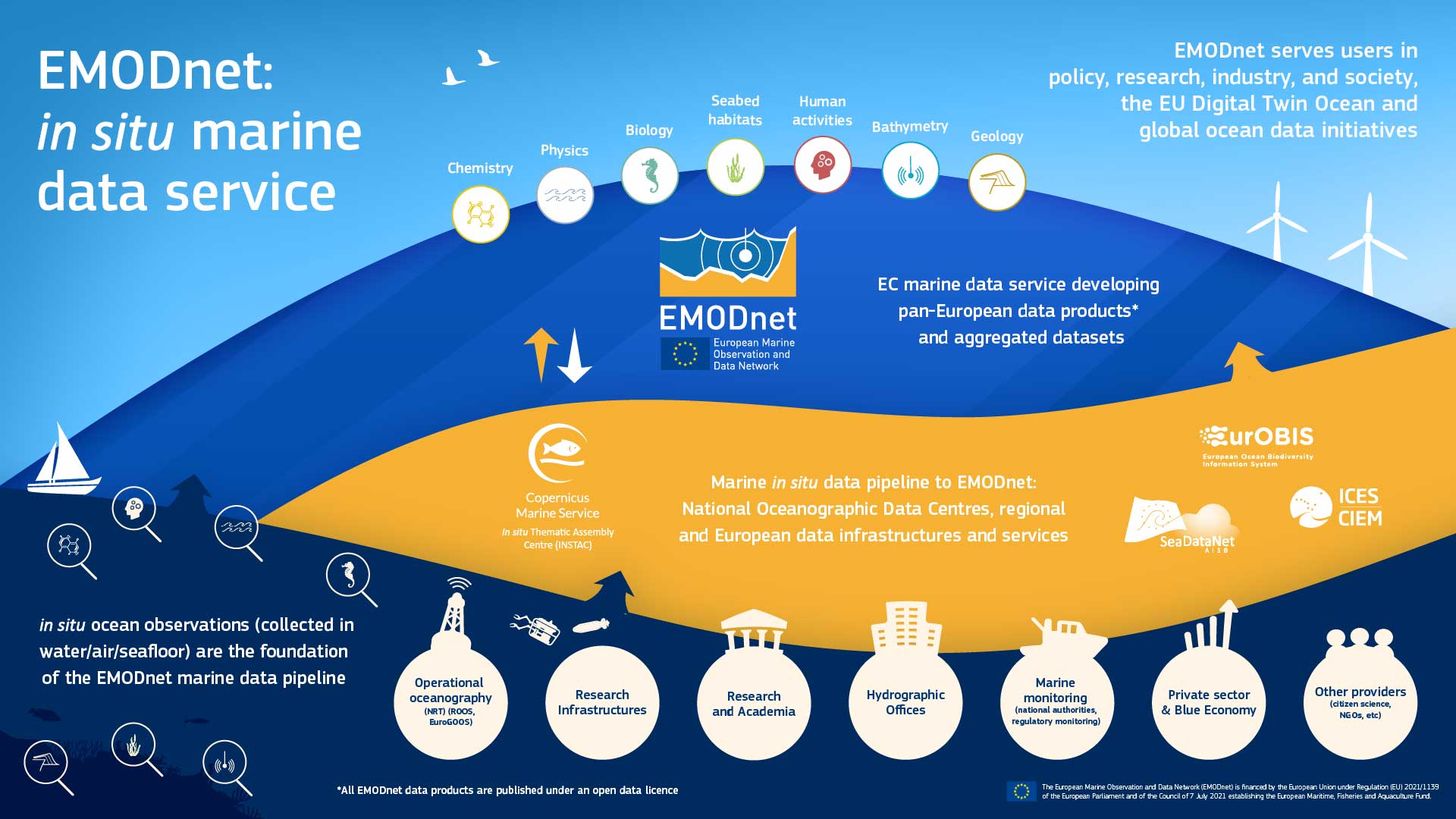
EMODnet, the European Marine Observation and Data Network, is a marine data service initiated by the European Commission in 2009. Funded by the European Maritime Fisheries and Aquaculture Fund with an average annual budget of EUR 7.5 million, EMODnet is a powerful driver for marine science and policy.
Working closely with Copernicus Marine Service, the other European Commission data service, EMODnet provides the data backbone for the EU Digital Twin of the Ocean.
EMODnet featured in Euronews' OCEAN series in September 2024.
Why marine data are essential
Marine data are essential to acquire a better scientific understanding of the marine environment, to provide marine knowledge for decision making, and to allow developing products and services supporting economic growth. Despite the critical need for high-quality, timely marine data, access has traditionally been fragmented, particularly for the in situ ocean data, which relate to what happens in the ocean interior rather than the surface. This is precisely the focus of EMODnet.
The Network addresses this challenge by centralising and streamlining data access, making data findable, accessible, interoperable, and reusable in accordance with EU and international standards.
“I have seen EMODnet grow from a network of marine communities to a single point of access supporting sustainable marine policies. It is now an integral part of the Green Transition, establishing good practices by providing good data.” said Charlina Vitcheva, Director-General for the European Commission’s Directorate-General for Maritime Affairs and Fisheries.
One portal, seven themes
EMODnet services are delivered by a network of 120 organisations working with Europe's ocean observation and data collection community. Through these partnerships, EMODnet offers a goldmine of marine information across seven key themes: bathymetry, geology, physics, chemistry, biology, seabed habitats, and human activities. All data are accessible through EMODnet central web portal.
Research and academia, policy and public administration, the private sector, non-governmental organisations and society at large all benefit from EMODnet's public and free data service covering these seven themes.
More than 100 use cases on the Portal show concrete examples of the many ways EMODnet supports its users.
Horizon Europe REMEDIES project, for example, used EMODnet to retrieve relevant historical marine litter data, and generate correct datasets. The project was able to develop a beach litter monitoring app, using the World Heritage site of Venice and its lagoon as a living laboratory.
Other notable achievements of EMODnet are the EUSeaMap, which offers a broad-scale seabed habitat map of all European sea basins, as well as the EU Digital Terrain Model, which provides harmonised bathymetric data (measuring the depth and contours of the ocean seafloor).
EMODnet is backed by a dedicated Secretariat, located in Belgium, that provides high-level coordination and technical support to the network, promotes EMODnet at European level and globally, and disseminates its results.
EMODnet partners include, among others, national oceanographic research and data centers, hydrographic offices and geological surveys responsible for managing marine data in their respective countries.
A key tool for global ocean monitoring
EMODnet is indispensable for the European Digital Twin of the Ocean, which is a highly accurate living replica of the ocean, fed by continuous observations from thousands of sensors across the world’s oceans and numerous satellites.
EMODnet integrates data from citizen science projects and expands accessibility through platforms like the European Atlas of the Seas, fostering ocean literacy and sustainable practices. Moreover, its collaboration with the Copernicus Marine Service enhances Europe’s capacity for global ocean monitoring, while partnerships with key research infrastructures and international data initiatives amplify its impact.
Get a closer look to this fascinating ever-evolving marine data service by visiting the EMODnet Central Portal and exploring their available tools and applications. Subscribe to their Newsletter and follow them on social media (YouTube, X and LinkedIn).
- Start date
- 15 May 2009
- Project locations
- Belgium
- Overall budget
- €7 500 000
- EU contribution
- €7 500 000100% of the overall budget
- Project website
- https://emodnet.ec.europa.eu/en
Stakeholders
Coordinators
Seascape Belgium bvba (EMODNet Secretariat, Belgium)
Mariene Informatie Service ‘MARIS’ BV (EMODnet Ingestion, The Netherlands)
- Website
- https://www.maris.nl/
Service Hydrographique et Océanographique de la Marine (SHOM) (EMODnet Bathymetry, France)
- Website
- https://www.shom.fr/
Vlaams Instituut voor de Zee VZW (VLIZ) (EMODnet Biology, Belgium)
- Website
- https://www.vliz.be/en
Istituto Nazionale di Oceanografia e di Geofisica Sperimentale (OGS)
- Website
- https://www.ogs.it/it
Geological Survey of Finland (GTK) (EMODnet Geology, Finland)
- Website
- https://www.gtk.fi/en/
Cogea srl (EMODnet Human Activities, Italy)
- Website
- https://www.cogea.it/en
ETT SPA (EMODnet Physics, Italy)
- Website
- https://ettsolutions.com/
Suomen ympäristökeskus (Syke) (EMODnet Seabed Habitats, Finland)
- Website
- https://www.syke.fi/en-US
